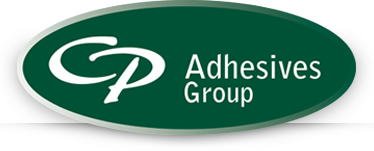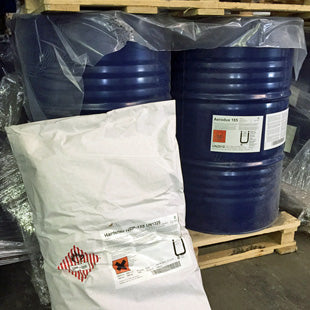Radio Frequency Gluing
Bonding with Radio Frequency Heating
Background of RF Heating:
The use of radio frequency is merely a means of obtaining heat to cure glue lines in wood-to-wood joints. It can be considered a source of heat, like steam and electricity, and is measured in the same units of heat and the same units of temperature that are used for any other heat source. The means of generating heat with radio frequency does differ from other sources. The electrical impulses or energy that are generated in suitable equipment are transmitted at very high cycles or frequency. Their passage through any mass results in some development of frictional heat, the degree dependent upon the electrical properties of this mass. In the case of wood which is a reasonably good insulator, considerable heat is realized. RF current, however, causes a uniform heating of the mass, in this case wood, so that the center is heated as fast and to the same degree as the outer surfaces. This is in contrast to other heat sources like steam where the heat migrates slowly from the surfaces to the center. The result is that RF current gives a very fast uniform temperature rise, and this phenomenon can be used to advantage for certain applications.
The radio waves in RF heating range in frequency from 2 to 30 megacycles which is slightly above the so-called "broadcast range" of 0.5 to 1.6 megacycles. In radio broadcasting, the waves are transmitted from a generator to an antenna where they are broadcast indiscriminately. However, in the case of gluing equipment the waves are transmitted or confined between plates or electrodes, and thus are put to use as a heat source when some mass like wood is inserted between these parts.
Types of RF Heating:
There are three types of RF heating recognized in the wood gluing field and their terminology stems directly from the location of the glue lines in relation to the direction of current flow.
1. Perpendicular Heating
This type is utilized to heat the entire mass of material placed between electrodes. Here, the glue lines are parallel to the electrodes but perpendicular to the flow of current between electrodes; hence, the term "perpendicular" is derived. This arrangement is generally used to bond flat or curved plywood, or for laminating purposes.
2. Parallel Heating
This set-up has the glue lines running at right angles to the electrodes, or parallel to the flow of RF current between electrodes. Thus, the name "parallel" has been derived. Since the glue lines are normally more conductive than the wood, current is usually concentrated into the area of the glue line to give a pattern of selective heating. As a result, very fast cures can be obtained in relatively short periods of time. This method of bonding is used primarily for edge-gluing applications.
3. Stray Field Heating
This type of heating has both electrodes located on the same side of the glue line. Although much energy flow passes directly between the electrodes, they can be designed to permit the energy to radiate outward from the electrodes and it is this phenomenon that adjacent mass of wood and glue lines to cause cure of the adhesive. Thus, the term "stray field" has been derived. This type of heating is generally utilized where it is impossible to place assemblies between electrodes for either perpendicular or parallel heating.
Mix Selection
The versatility of urea resins makes them suitable for use under RF conditions regardless of the cure method involved; only the proper mix and catalyst selection is necessary for optimum results. For perpendicular heating a lightly extended mix and catalyst as previously described for use with restraining clamps is suggested. For parallel or stray-field heating, a more "selective" catalyst is required.
To Increase Liquid Life: Keeping the mixed glue at a low temperature, down to 40F, will increase Liquid Life considerably. When liquid resin is used, the resin itself can be kept in cold storage compartments. When powder resin is used, cold water 40-50F, can be used in mixing. The completed mixtures can then be kept in cold cabinets and water cooled glue reservoirs. Although very cold glue mixes require extra time for curing, this increase would be negligible for "very fast" and "fast" glues, and only slight for "moderate" speed glues.
Stock Moisture Content
With all methods of cure stock moisture content is critical. A 9% maximum and 7% optimum is recommended and all stock within one press load should be with + 1%. A 5% minimum is necessary to prevent premature glue line dryout.
Stock Preparation
All stock should be free of dirt, grease, or oil. In edge-gluing or laminating accurate machining is especially important to produce tight-fitting, well-mated joints.
Spreads
For all types of heating, the adhesive spread should be only sufficient to show a slight bed of squeeze-out when the pressure is applied to the stock. This will usually be 32 to 36 lbs/MSGL. It is generally preferred to apply a relatively light spread of a heavy mix than a heavy spread of a thin mix.
Assembly Time
Due to the rapid rate of cure, adhesive transfer must be accomplished within the first few seconds after pressure is applied; therefore, the total assembly time is limited to less than the time it takes the spread adhesive to dry to the touch.
Estimating Curing Cycles
Although the time required to obtain cure of the resin by radio frequency heating depends on numerous factors such as species of wood, its mass, area of glue lines and temperature rise required, there are nevertheless ways of quickly estimating the cure cycle involved. In the case of perpendicular gluing, first determine the weight of the wood and adhesive involved in a given charge and multiply this value by the specific heat of wood (0.45). The resultant value is then multiplied by the temperature rise needed (difference between ambient temperature and final curing temperatures of 210-220F). This calculation is the number of BTUs (British Thermal Units) required to heat the charge to obtain glue cure.
This figure must be converted since most U.S. dielectric curing generators have their electrical output rated in Kilowatts rather than BTUs. Therefore, divide the resultant BTU. figure by 56 which is the approximate number of BTUs in one kilowatt minute. The value of kilowatt minute must be divided by the kilowatt rating of the generator to give the approximate time required to cure the glue lines in the work load.
Example #1
A 30 pound assembly at an ambient temperature of 75F is to be cured in a 15 K.W. unit. How long a heating period is required to cure the glue lines? First, multiply the weight of the load (30 pounds) times the specific heat of wood (0.45) which equals 13.50. Then, multiply by the temperature rise (200F - 75F 145) The resultant value is 1958 BTUs. This value is divided by 56, the D.T.'s in 1 kilowatt minute or approximately 35 kilowatt minutes. Divide this value by the rating of the generator which is 15 KW to give a value of approximately 2-1/3 minutes cure time.
Example #2
For parallel heating that involves edge gluing of lumber cores, a rule of thumb is that one KW will cure approximately 100 square inches of glue line per minute. This will vary somewhat with species of wood and type of adhesive. Calculations for stray field heating are not too well defined, but the procedure used in perpendicular heating can be used as a guide.
To increase curing speed, use either of these two variations in the mixing formula:
For parallel heating where electrodes come in direct contact with the glue line
Use up to 2 parts sodium chloride (table salt) to 100 parts resin. Dissolve the salt in the mixing water, when water is used. The salt makes the mix more conductive so that it draws more power and hence sets faster. This will increase; however, the tendency to arc. Tests should be made to determine the maximum amount of salt (up to 2%) to be used.
For perpendicular heating
Alcohol may be substituted for up to 25% of the mixing water. The use of alcohol reduces curing time and provides better wetting of the wood surface.
Definition of Burning and Arcing
Two of the most common faults encountered in radio frequency gluing are "arcing" and "burning". The terms are sometimes used synonymously, but actually they are separate problems resulting from different circumstances in radio frequency heating.
Arcing is generally attributed to a type of dielectric break down resulting in a tree-like appearance from top to bottom within the glue line cross section. It usually starts at either the top or bottom edges of the glue joint and follows to the opposite side. The cross section appearance resembles that of a tree and is easily identified since the defect is black or carbonized color. It is generally caused by a highly conductive path being set up parallel to the electric field between top and bottom electrodes. This causes arcing and is reflected in an overload on the generator, but suitable safeguards are installed on the equipment so that power is shut off quickly before any substantial damage can be done.
Burning shows a linear configuration and is generally caused by a high voltage gradient setup within a small are of the assembly. This may be caused by several factors, such as irregularities on the wood surfaces adjacent to the glue line, peculiarities in the wood anatomy, or the adhesive complexities associated with this problem.
Operation of Equipment
The dielectric or radio frequency heating equipment available today for wood gluing purposes is a highly engineered apparatus that contains all possible safeguards to make the operation a safe and easy one. The actual operation of the equipment is usually very simple and the operator has a minimum of instruments to watch during the curing cycle. Operating directions vary with the type and make of equipment and it is suggested that the manufacturer be contacted directly on these matters.
- Choosing a selection results in a full page refresh.
- Press the space key then arrow keys to make a selection.













